Princes of Kiev
The Rise of the First Russian Empire
"The birth of the Russian Empire falls
in the period when the Scandinavian Vikings were at the zenith of their
power. Just as these hardy rovers sailed over the Baltic, the Atlantic
and the Mediterranean, until they reached Iceland and North America, and
in their small forty oared galleys went up from the mouths of the Elbe,
the Weser, the Rhine, the Maas and the Seine far into the interior, striking
terror into the inhabitants, so, too, in the east of Europe they followed
the course of the rivers and discovered the way to the Black Sea and Constantinople.
The route which led up the Dwina and then down the Dnieper to Byzantium
was called the Varagian way; even the rapids of the Dnieper bore, so it
is said, Scandinavian names. The Norsemen, who had founded here and there
independent empires in the west of Europe, could do so still more easily
in the east."
.....The Book of History, Vol. VIII, pg. 3285 (London,
1914)
"The recorded Russian history of the Poutiatine family began in the 9th
century, when Slavonic and Finnish inhabitants of the northern land
turned to the powerful Varangians, who were Scandinavians, to rule
their land. These warriors called themselves Russ, the eldest of which
Prince Riurik settled in the Novgorod Region and became the founder of
the first Russian dynasty of rulers. The Poutiatine family was direct
descendents of Prince Riurik and to the Romanov family."
......Personal Recollections of Princess Nathalie Poutiatine (1904 - 1984)
by Tanya Bajona, the Tanya Bayona Princess Poutiatine Academy of Ballet in Sliema, Malta
with thanks to Desmond McAllister.
Click to visit Desmond McAllister's website.
Generation One
Rurik, Grand Prince of Kiev
Born circa 800
Died in 879
Rurik, the Viking leader who
is traditionally credited with founding the Russian state, was born in
Friesland, a region in present-day Holland, which his father controlled.
After leading raids in France, England, and Germany, Rurik gained control
of a large tract of land in Jutland. However, he soon abandoned his claim
under pressure from rival chieftains.
In the 850s, Rurik and his brothers Sineus
and Truvor led a band of Vikings into northwestern Russia where they established
a settlement near Lake Ladoga in what is now northeastern Russia very near
the border with Finland. Rurik soon moved part of the settlement to nearby
Novgorod, according to legend, at the invitation of the local Slavs. There
he established the seat of his power and built a fortress from which he
could rule the Russian lands. His rule extended as far south as Kiev where
his successors founded the powerful Kievan state, which lasted until the
1200s.
From Rurik came the house of Rurikovitch
which ruled Russia until the end of the 16th century. |
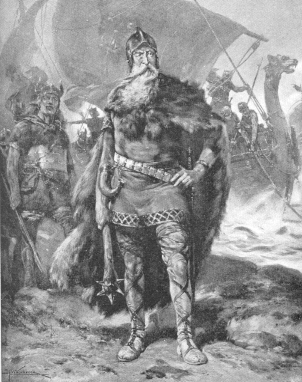 |
Rurik had a son:
-
Igor, Grand Prince of Kiev
Generation Two
Igor, Grand Prince of Kiev
Born circa 875 at Novogorod, Kiev
Acceded: 924
Died in 945, murdered by the Drevlanes from the town
of Korosten
Although said to be less capable than
leaders before and after him, Igor nontheless carried the conquests of
Kievian Rus further. He undertook campaigns against Persia, Constantinople
and Bulgaria.
Igor married in 903 to St. Olga, Regent of Kiev, who was
born circa 890 and died in 969.
Igor and Olga had a son:
-
Svyatoslav I, Grand Prince of Kiev
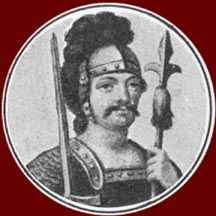
|
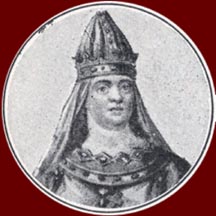
|
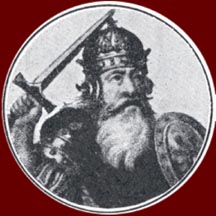
|
Igor
Grand Prince of Kiev
924 - 945
|
St. Olga
Regent of Kiev
945 - 964
|
Svyatoslav I
Grand Prince of Kiev
945 - 972
|
Generation Three
Svyatoslav I, Grand Prince of Kiev
Born circa 942
Acceded in 945
Died in 972, ambushed and killed.
Svyatoslav was only about three years
old when his father Igor was murdered in 945, hence his mother St. Olga
acted as Regent of Kiev until 964. Olga's first official act was to wreak
vengeance on the Drevlanes who had murdered her husband by besieging and
burning their town of Korosten. In 957 Olga went with a large retinue to
Constantinople, accepted Christianity, and received baptism.
In 964, Svyatoslav took over the government,
although his mother continued to administer home affairs until her death
in 970. Svyatoslav led Kievan Rus's military conquest of the
Bulgars, responding to attacks by the Khazar tribe. He in turn was
ambushed and killed by Byzantines from Pecheneg in the south, who, according
to legend, converted Svyatoslav's skull into a drinking vessel.
Svyatoslav married Malousha and they had a son:
-
St. Vladimir the Great, Grand Prince of Kiev
Svyatoslav married to Predeslava of Hungary and they had
the following children:
-
Yaropolk I, Grand Prince of Kiev, 972 - 978; his son,
-
Svyatopolk I, Grand Prince of Kiev 1015 - 1019
Generation Four
St. Vladimir the Great, Grand Prince of Kiev
Born in 960
Acceded in 978
Died on July 15 1015 at Kiev
Vladimir was a pagan at the beginning
of his reign, which was at first devoted to consolidating his territories
into a unified Russian state. By the early 10th century, however, Kievan
Rus had established close commercial and cultural ties with the Byzantine
Empire, an Orthodox Christian state. He converted in 988 to Orthodox
Christianity and made Orthodoxy the official religion of Kievan Rus.
Vladimir's choice of Orthodox Christianity, rather than the Latin church
(Roman Catholicism) or Islam, had an important influence on the future
of Russia.
.....Microsoft® Encarta® Encyclopedia 99.
© 1993-1998 Microsoft Corporation.
 |
Vladimir's choice between the Christian and Islamic faiths
was said to have been heavily influenced by the fact that he enjoyed the
consumption of alcoholic beverages. The Christian faith allowed for
this and the Islamic faith did not. Hence, Validimir chose Christianity. |
 |
St. Vladimir married in 980 to Rogneda von Polotzk,
a Nun and a daughter of Rognald of Polotzk. Rogneda died in 1002.
St. Vladimir and Rogneda the Nun had a son:
-
Yaroslav I the Wise, Grand Prince of Kiev
St. Vladimir married after 1011 to Malfreda of Bohemia, a
daughter of Kuno, Count of Ohningen, by Richilde who was a daughter of
Otto I the Great, King of Germany.
St. Vladimir and Malfreda had a daughter:
-
Dobroniega (also Dobronega or Maria) who married in 1038
to King Casimir I, King of Poland.
St. Vladimir the Great had many additional wives and girl
friends; and many more children.
For details, see George Andrews Moriarty: The
Plantagenet Ancestry of King Edward III and Queen Philippa, Mormon
Pioneer Genealogical Society, Salt Lake City, Utah, 1985, page 53.
Generation Five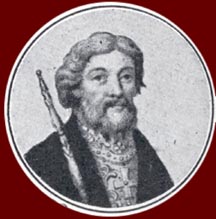
Yaroslav I the Wise, Grand Prince of Kiev
Born in 978
Acceded in 1019
Died on Ferburary 20, 1054 at Kiev
Kievan Rus achieved its greatest power
and splendor under Yaroslav the Wise in the 11th century. Yaroslav made
Kiev a great city and built magnificent buildings, including the notable
Cathedral of Saint Sophia or Hagia Sophia of Kiev. Yaroslav did much to
develop Kievan Rus education and culture. He also revised the first Russian
law code, the so-called Russkaya Pravda or Russian Justice.
After his death in 1054, Kievan Rus declined. Yaroslav's grandson,
Vladimir II Monomachus, made the final attempt to unite Kievan Rus, but
after his death in 1125 the fragmentation continued as other Kievan Rus
principalities challenged Kiev's supremacy.
By the 13th century, the East Slavic
lands became a loose federation of city-states, held together by common
language, religion, traditions, and customs. Although ruled by members
of the house of Rurik, these city-states were often at war with one another.
The area became an easy target for bands of invading Asiatic Mongols.
.....Microsoft® Encarta® Encyclopedia 99.
© 1993-1998 Microsoft Corporation.
Yaroslav married 1019 to Ingeborg, a daughter of
Olaf Skötkonung, King of Sweden.
Yaroslav and Ingeborg had the following children:
-
Anne of Kiev
-
Isiaslav I, (1025 - 1078) Prince of Kiev, married a daughter
of King Mieszko of Poland.
-
Wsevolod I, (1030 - 1093) Prince of Kiev.
-
Anastasia of Kiev, married circa 1046 to Andrew I, King of
Hungary.
Generation Six
Anne of Kiev
Born in 1024
Died after 1075
Anne married on January 20, 1044 to Henry
I Capet, King of France and they had the following sons:
-
Philip I the Fair Capet, King of France, born in 1052
-
Hugh "the Great" de Crépi, Count of Vermandois
For the continuation of this line, click on
Henry
(I) Capet, King of France.
Sources
The information presented here
has been taken from the following sources:
Frederick L. Weis and Walter L. Sheppard: Ancestral
Roots, 7th Edition, Baltimore, 1999
World Book Millenium 2000 Deluxe Edition,
© 1999 World Book Inc., © IBM Corp.
Microsoft Encarta Encyclopædia 99,
© 1993-1998 Microsoft Corporation
Norman F. Cantor (ed.) The Encyclopædia of
the Middle Ages, New York, 1999
George Andrews Moriarty: The
Plantagenet Ancestry of King Edward III and Queen Philippa,
Mormon Pioneer Genealogical
Society, Salt Lake City, Utah, 1985.
The Book of History (18 Volumes), London, 1914
Mediæval
History Guide,
http://historymedren.about.com/index.htm
Please visit the Sewell
Genealogy Site Map for other pages in this series.








